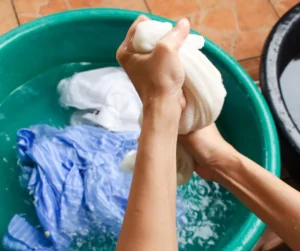When it comes to maintaining the quality and longevity of your clothes, understanding the differences between wet wash and dry cleaning is essential. Each method has unique advantages and is suited for various types of fabrics. Let’s dive into this fabric care showdown to help you decide which method is best for your wardrobe.
Wet Wash: The Basics

Wet wash involves using water and detergent to clean fabrics. This method is commonly used for everyday laundry and works effectively on many materials.
Advantages of Wet Wash
- Versatility: Ideal for everyday fabrics like cotton, polyester, and denim. Most household items, including t-shirts and sheets, can be safely washed this way.
- Effective Stain Removal: Wet washing is great for removing water-soluble stains, such as dirt and sweat.
- Cost-Effective: Washing at home is typically less expensive than dry cleaning, making it a practical choice for regular maintenance.
Disadvantages of Wet Wash
- Potential for Damage: Delicate fabrics, such as silk and wool, can shrink or become damaged in water.
- Color Bleeding: Mixing different colors without sorting can lead to unwanted color transfer, especially with new or dark garments.
Dry Cleaning: The Essentials

Dry cleaning employs chemical solvents rather than water to clean fabrics. This method is particularly beneficial for delicate or structured garments.
Advantages of Dry Cleaning
- Gentle on Delicates: Ideal for fabrics like silk, lace, and wool that require special care.
- Preserves Shape and Color: Dry cleaning maintains the original appearance of structured clothing, such as suits and evening gowns, preventing distortion.
- Effective for Tough Stains: Dry cleaning is particularly effective at removing oil-based stains that may not come out in a traditional wash.
Disadvantages of Dry Cleaning
- Higher Cost: Generally more expensive than wet washing, especially for multiple items or specialty garments.
- Environmental Concerns: Traditional dry cleaning methods can use harmful solvents, though many cleaners now offer eco-friendly options.
When to Choose Each Method
Opt for Wet Wash When:
- You’re cleaning everyday wear: Items like casual shirts, jeans, and bed linens are safe for wet wash.
- The fabric is durable: Cotton, polyester, and synthetic blends can withstand the washing process without damage.
Choose Dry Cleaning When:
- You have delicate fabrics: Always dry clean silk, lace, and wool to avoid shrinkage and damage.
- You’re caring for special occasion wear: Formal dresses and suits benefit from dry cleaning to keep them in pristine condition.
Conclusion
Understanding when to use wet wash versus dry cleaning can significantly extend the life of your clothing. By recognizing the specific care needs of each garment, you can make informed decisions that keep your wardrobe looking its best. For tailored advice and expert services, consider reaching out to professionals like FCL Laundry and Dry Cleaning to ensure your clothes receive the care they deserve.